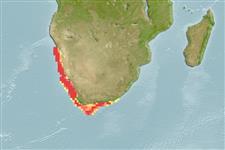>
Ophidiiformes (Cusk eels) >
Ophidiidae (Cusk-eels) > Ophidiinae
Etymology: Genypterus: Greek, geny, -yos = face, jaw + Greek, pteron, = wing, fin (Ref. 45335).
Environment: milieu / climate zone / depth range / distribution range
Ecologie
marien bathydemersaal; diepte 50 - 500 m (Ref. 4103), usually 250 - 350 m (Ref. 27121). Deep-water; 21°S - 37°S, 12°E - 28°E (Ref. 34024)
Eastern Atlantic: Walvis Bay, Namibia to Algoa Bay, South Africa. Distinctiveness of this species and Genypterus blacodes is unclear (Ref. 34024).
Lengte bij maturiteit / Grootte / Gewicht / Leeftijd
Maturity: Lm 67.5, range 60 - 75 cm
Max length : 180 cm TL mannelijk / geslacht onbekend; (Ref. 3686); max. gepubliceerd gewicht: 15.0 kg (Ref. 9988)
Korte beschrijving
Determinatiesleutels | Morfologie | Morfometrie
Dorsale zachte stralen (totaal) : 150; Anale zachte stralen: 110. Head and body usually pinkish to orangish with dark spots and blotches especially dorsally (Ref. 34024).
Occur in rocky areas of the shelf and upper continental slope. Juveniles found in shallow waters than adults (Ref. 36731). Benthic and common species (Ref. 34024). Feed on dragonets, mantis shrimps, hake, squid, and various fishes (Ref. 27121). Spawning occurs from August to October. Oviparous, with oval pelagic eggs floating in a gelatinous mass (Ref. 205). Utilized fresh and frozen; can be fried and baked (Ref. 9988).
Nielsen, J.G., D.M. Cohen, D.F. Markle and C.R. Robins, 1999. Ophidiiform fishes of the world (Order Ophidiiformes). An annotated and illustrated catalogue of pearlfishes, cusk-eels, brotulas and other ophidiiform fishes known to date. FAO Fish. Synop. 125(18):178p. Rome: FAO. (Ref. 34024)
Status op de Rode Lijst van het IUCN (Ref. 130435: Version 2024-1)
Gevaar voor de mens
Harmless
Gebruik door de mens
Visserij: commercieel
Tools
Speciale rapporten
Download XML
Internetbronnen
Estimates based on models
Preferred temperature (Ref.
123201): 9 - 15.5, mean 9.5 °C (based on 14 cells).
Fylogenetische diversiteitsindex (Ref.
82804): PD
50 = 0.5156 [Uniqueness, from 0.5 = low to 2.0 = high].
Bayesian length-weight: a=0.00224 (0.00115 - 0.00435), b=3.16 (2.99 - 3.33), in cm total length, based on LWR estimates for this species & (Sub)family-body (Ref.
93245).
Trofisch niveau (Ref.
69278): 4.4 ±0.61 se; based on food items.
Weerstandsvermogen (Ref.
120179): laag, minimale populatieverdubbelingstijd 4,5-14 jaar (K=0.06-0.14; tm=4-5).
Prior r = 0.17, 95% CL = 0.11 - 0.26, Based on 1 full stock assessment.
Fishing Vulnerability (Ref.
59153): High to very high vulnerability (73 of 100).
Climate Vulnerability (Ref.
125649): High vulnerability (64 of 100).
Nutrients (Ref.
124155): Calcium = 12.1 [7.6, 26.2] mg/100g; Iron = 0.354 [0.185, 0.683] mg/100g; Protein = 15.6 [13.7, 17.7] %; Omega3 = 0.242 [0.131, 0.475] g/100g; Selenium = 26.1 [11.8, 57.4] μg/100g; VitaminA = 8.8 [1.9, 40.5] μg/100g; Zinc = 0.247 [0.165, 0.370] mg/100g (wet weight);
